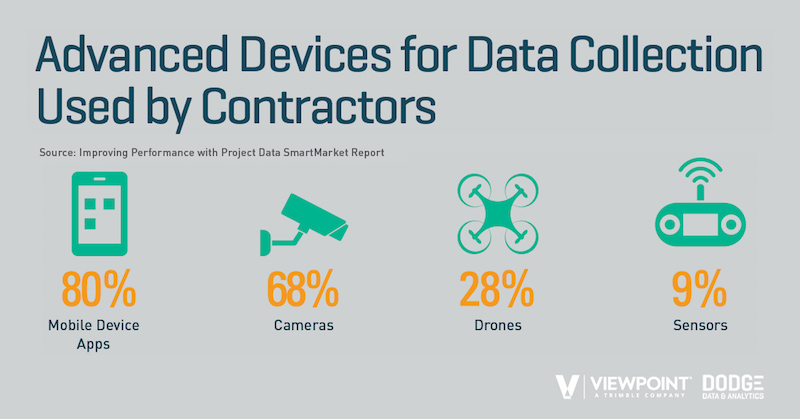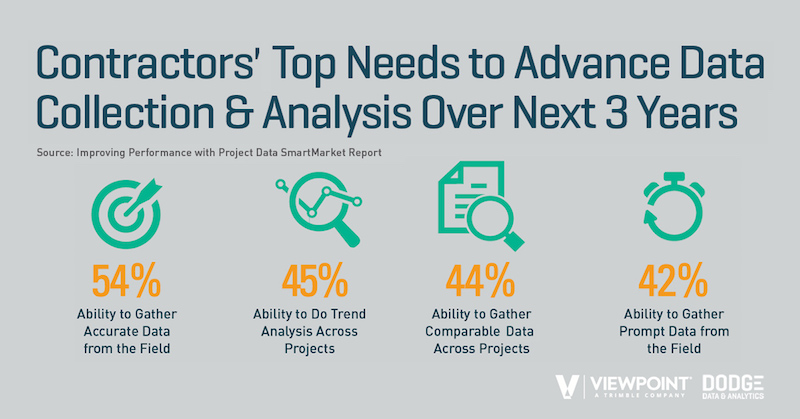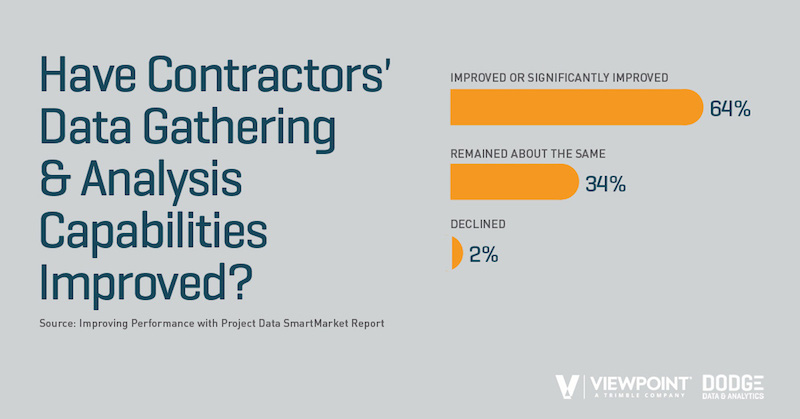More than half of contractors say their methods of collecting and analyzing data from their jobsites need to get better over the next three years, in part for their companies to use these data to predict employee and project performance.
That’s a key finding in a new 40-page SmartMarket report that Viewpoint and Dodge Data & Analytics have released, entitled “Improving Performance with Project Data.”
The report is based on an online survey conducted from August 14, 2017 through September 12, 2018. The survey used Dodge’s Contractor Panel and contacts provided by Viewpoint. Of its 187 respondents, 98 were GCs, 47 specialty trade contractors, 28 construction managers, nine design-build firms, and four design-contracting firms. Thirty seven percent of respondent companies generate revenues between $50 million and $250 million.
The research focused on five key types of data: project progress, man hours, productivity, safety, and equipment management.
Respondents were asked how they gather, store, manage, secure, analyze and report on each of these types of data. Key trends include a rapid shift away from paper-based forms, reports, and spreadsheets to digital tools and platforms, some that leverage cloud technology; increasing use of apps on mobile phones and digital cameras in the field; the desire for more accurate field data that enable trend analysis across projects; and a focus on data security.

Mobile devices are providing contractors with better ways to gather, input, and store information. Drones and sensors are adding to these data cocktails. Image: Dodge Data & Analytics
Data can improve a project’s productivity
More than three fifths of the contractors surveyed say they’ve seen improvements in their data gathering and analysis capabilities over the past three years. That’s especially true among larger companies. By far, the most important project data being gathered are performance information such as scheduling and costs, followed by payroll and man hour data.
The top three benefits from data analysis, say contractors polled, are improving their ability to complete projects at or under budget (53%), greater productivity (47%) and greater profitability (46%).
However, more than half of the respondents (54%) admitted that they need to improve how they gather jobsite info over the next three years. And 45% think their ability to analyze trends across projects must to get sharper, too, as well as their ability to gather current data from the field.
Relying on physical records, like paper forms or spreadsheets, for data collection is steadily giving way among contractors to custom-designed or commercial software, a trend that is likely to be more prevalent over the next three years. Nearly three-quarters of respondents say they were satisfied with using software as a way to collect data.
Most pros (65% of the ones polled) still store their digital information in on-premise servers. But 37% have turned to third-party cloud providers, such as Amazon, to host their field information. The benefits of using the cloud are manifold, the most prominent being the ability to access data from the field while working in the office or remote locations, and vice versa.
Well over half of the contractors surveyed deploy mobile phone apps and cameras to collect and send data from the field. Expect that wave of data to rise, as drones, sensors, and wearables gain more traction as jobsite tools. However, contractors are also acutely aware of how their use of devices presents security risks. That explains why 86% of contractors say they are using anti-malware software, 78% are using enterprise-grade firewalls, and 56% have imposed policies for managing the use of mobile devices.

Contractors acknowledge that they need to be doing a much better job at collecting information from the field, and analyzing that information for purposes of predictive decision making. Image: Dodge Data & Analytics
Proffering a plan to gather data
More than one-fifth of contractors surveyed have had experience with predictive analysis of data and business intelligence. That compares with just 7% for artificial intelligence and 6% for machine learning. The largest group of respondents noted they are aware of and understand the concepts of each of these emerging technologies but have not implemented them in their own organizations — 39% for predictive analysis; 47% for artificial intelligence; and 33% for machine learning.
But it is clear that technology is advancing faster than the AEC industry’s ability to assimilate it. The report’s authors offer a four-step process to structure a company’s data collection, analysis, and reporting.
•Determine what aspects of project delivery would benefit most from better information to guide your data strategy
•Identify which types of field data will best-enable the proper analysis to generate critical decision-support information. And think about the minimum level of completeness, accuracy, and timeliness required for each type.
•Develop a focused technology and plan for collection and analysis that incorporates the specific data needed and types of analysis required, as well as financial and human capital investments, the time frames for implementation, clear roles of responsibility, and measurable goals for success.
The report includes two case studies—how Leander Construction is using the cloud to enhance productivity; and how W. Soule & Co. is using data to build better—as well as a Q&A with Jit Kee Chin, Suffolk Construction’s high-profile Chief Data Officer. Chin laments that what’s keeping AI from becoming a more efficient construction tool is still the lack of useful data. Her viewpoint may explain why she sees “great potential” in automated monitoring.
Related Stories
Transportation & Parking Facilities | Aug 23, 2023
California parking garage features wind-activated moving mural
A massive, colorful, moving mural creatively conceals a newly opened parking garage for a global technology company in Mountain View, Calif.
Digital Twin | Jul 31, 2023
Creating the foundation for a Digital Twin
Aligning the BIM model with the owner’s asset management system is the crucial first step in creating a Digital Twin. By following these guidelines, organizations can harness the power of Digital Twins to optimize facility management, maintenance planning, and decision-making throughout the building’s lifecycle.
Designers | Jul 25, 2023
The latest 'five in focus' healthcare interior design trends
HMC Architects’ Five in Focus blog series explores the latest trends, ideas, and innovations shaping the future of healthcare design.
Digital Twin | Jul 17, 2023
Unlocking the power of digital twins: Maximizing success with OKRs
To effectively capitalize on digital twin technology, owners can align their efforts using objectives and key results (OKRs).
Standards | Jun 26, 2023
New Wi-Fi standard boosts indoor navigation, tracking accuracy in buildings
The recently released Wi-Fi standard, IEEE 802.11az enables more refined and accurate indoor location capabilities. As technology manufacturers incorporate the new standard in various devices, it will enable buildings, including malls, arenas, and stadiums, to provide new wayfinding and tracking features.
Virtual Reality | Jun 16, 2023
Can a VR-enabled AEC Firm transform building projects?
With the aid of virtual reality and 3D visualization technologies, designers, consultants, and their clients can envision a place as though the project were in a later stage.
AEC Innovators | Jun 15, 2023
Rogers-O'Brien Construction pilots wearables to reduce heat-related injuries on jobsites
Rogers-O'Brien Construction (RO) has launched a pilot program utilizing SafeGuard, a safety-as-a-service platform for real-time health and safety risk assessment. Non-invasive wearables connected to SafeGuard continuously monitor personnel to prevent heat exhaustion on jobsites, reducing the risk of related injuries. RO is the first general contractor to pilot this program.
Contractors | May 26, 2023
Enhanced use of data is crucial for improving construction job site safety
Executives with major construction companies say new digital tools are allowing them to use data more effectively to reduce serious safety incidents and improve job site safety.
AEC Tech Innovation | May 12, 2023
Meet Diverge, Hensel Phelps' new ConTech investment company
Thai Nguyen, Director of Innovation with Hensel Phelps, discusses the construction giant's new startup investment platform, Diverge.
AEC Tech | May 9, 2023
4 insights on building product manufacturers getting ‘smart’
Overall, half of building product manufacturers plan to invest in one or more areas of technology in the next three years.

















